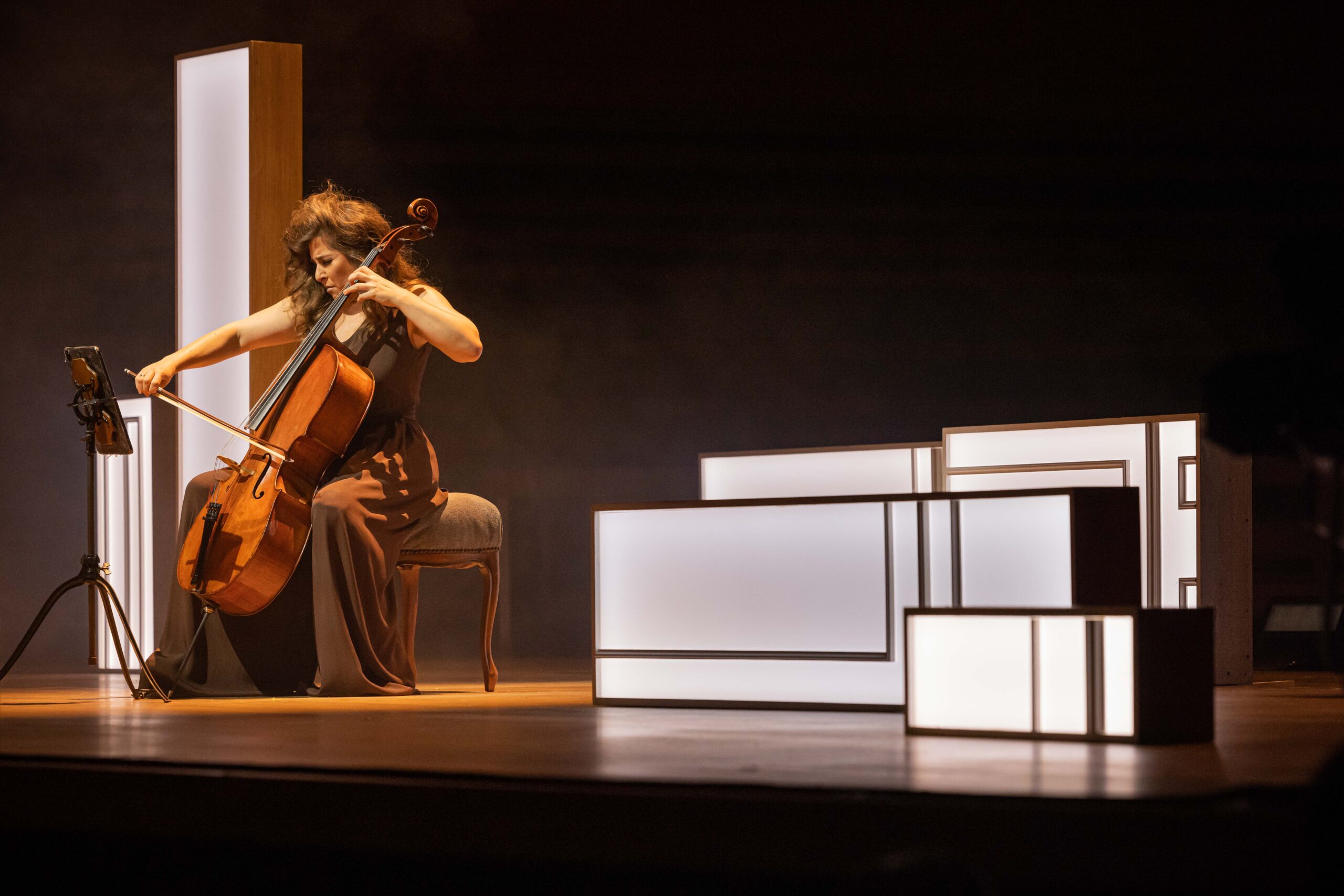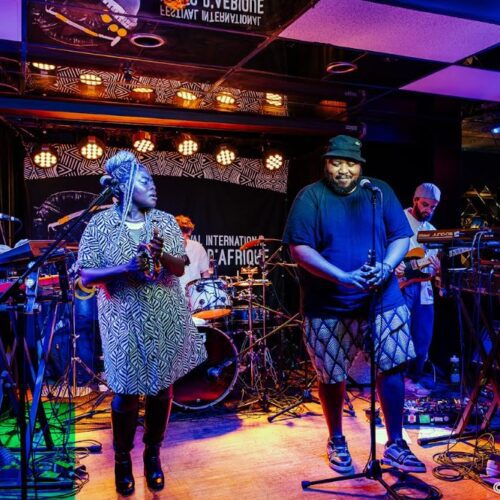
concert Fragments
cr.: Antoine Saito

concert Fragments
cr.: Antoine Saito

concert Fragments
cr.: Antoine Saito

concert Fragments
cr.: Antoine Saito

concert Fragments
cr.: Antoine Saito

concert Fragments
cr.: Antoine Saito
Last night, at the Maison symphonique de Montréal, an encounter took place that was both delightful (for some) and disconcerting (for others): a concept concert entitled Fragments, conducted intensely for two hours, solo, by cellist Alisa Weilerstein (Rafael Payare’s partner). How would you sum up the concept? There are six Suites for solo cello by Johann Sebastian Bach, as you probably already know. To each of these Suites, Weilerstein has added several compositions (also for solo cello) specially commissioned from a wide range of contemporary composers. Each suite becomes a cycle entitled Fragments (from 1 to 6).
Within these Fragments, everything is mixed between movements from the suites (not even played in the usual order, with the famous Prelude from the first suite arriving at the end of Fragment I!) and new compositions. The only consideration is that the sequences follow a dramatic and expressive arc, supported by a rather sober but subtly expressive staging. This is achieved through two fundamental elements: variously placed blocks/panels lit from within (each Fragment has its own particular “placement”), and dynamic general lighting that changes as the Fragment in question unfolds. In this way, each hour-long Fragment becomes a musical theater with a unique dramaturgy. As you will have gathered, Weilerstein did not play all six Fragments of his total project yesterday. The concert would have ended in the middle of the night! Instead, we were treated to the first two in the series.
Note that this concert is part of the Bach 2023 Festival program. The full program is online here.
But then, you’re here to find out if it was any good, aren’t you? Of course, it depends on individual sensibilities, but for my part, I’m very happy with the result, and I’m very keen to get to know the other four cycles in the series.
I’m not going to inundate you with a description of every piece linked to every other piece, and this Bach movement and that. That would be like describing a grocery list. Instead, I’ll try to characterize each of the two Fragments heard, because that’s the whole point: it’s an artistic proposition that puts Bach back into context within contemporary musical cycles with their own unique personalities. At least, that’s what I understood from the exercise.
Fragments I is organic, fluid and “pacifist”. The relationship between the contemporary pieces and those taken from the Suite G major, BWV 1007 (No. 1) is generally benevolent, although there are occasional contrasting flashes. Joan Tower, Reinaldo Moya, Chen Yi, Gil Schwarzmann and Allison Loggins-Hull have created a dialogue of post-minimalism, lyrical modernism and even Latin and Chinese sounds (very diluted, no pop “crossover” here) with the great Johann Sebastian. The scenography and lighting are made up of fairly obvious symbolic characterizations: the cubes/panels are arranged in a balanced manner, in a perfect semicircle and encircling the soloist like the interior of a temple. A stage on the stage. What’s more, they turn white for each Bach movement (a symbol of purity?). For the others, we have warm shades of red, blue and orange. The transitions between pieces are quite natural. We’re on an emotional journey here, offering viewers a surprising yet friendly introduction. The modernity of the new pieces is not astringent, though still demanding in terms of attentive listening.
Fragments II is different. From the outset, Weilerstein is herself in a different persona: dressed more “moderately” and, above all, coiffed in a “glam-rock” style. The music gets off to a flying start: a rhythmic, dynamic frontal attack with a piece by Quebecer Ana Sokolovic that spits its virulence at the audience. The message is out: we’re somewhere else. In fact, the whole of Fragment II is marked by a much more aggressive personality than the first (but not only, as a superb final episode in which Weilerstein sings a gentle lullaby while accompanying himself offers a moment of great poetic tenderness). Fragment II is a cycle of striking contrasts, in which Bach and our contemporaries collide and pit themselves against each other. But there is a dialogue. An argumentative dialogue in which we don’t always agree, but which nonetheless reflects a very current reality: not everything is rosy and harmonious in a world of good intentions. New ideas and perspectives are born of the clash. The staging, once again, clearly characterizes this personality: the cubes/panels are, this time, scattered around the stage, some lying down. One has the impression that the temple evoked in the first Fragment is now in ruins. Bach continues to be in white, but the stage lighting is much cruder than in the first part. Edge-on spotlights often assault the soloist. The pieces in this cycle don’t follow on from one another, but bump into one another. So it’s the worlds of Ana Sokolovic, Caroline Shaw, Gity Razaz, Daniel Kidane and Alan Fletcher that have the wrong role here: that of making Bach seem salvific in a world in perdition.
That said, the new works by these composers are not, in all honesty, that terrible. We’ve heard far worse. True, they are often rhythmically motoric, or dynamically explosive, but the discourses offered are comprehensible. All the pieces “tell” something, dramatically speaking, although it can be anything, and very different depending on who’s listening. My point is that there is no example anywhere of dodecaphonic or cerebral serial atonalism. Nor is there anything that could be called experimental avant-garde. Nor, conversely, is there anything frankly neo-classical/romantic or strictly minimalist. Perhaps this is where Weilerstein could have dug deeper, to give a more realistic portrait of today’s music. I admit that the cohesive work would have been tenfold. But no one says that true creation is simple.
The majority of the audience at the Maison symphonique, although not full, reacted favorably. Some of the audience didn’t return after the first Fragment, and a few left during the second. Still, there was an appreciable number of young people, and I didn’t think they were among the deserters! I’m just saying…
One colleague suggested that there might be no point in the exercise if Bach had to be “hijacked” (in his defence, I think he was referring to Weilerstein’s very full, romantic approach to playing in the Suites excerpts, but his general opinion of the concept wasn’t much more enthusiastic…). I wonder how we can still be at this point in our thinking. I can’t find the reference anymore (who said this at the time?), but Liszt’s arrangements of Beethoven’s symphonies for solo piano generated the same kind of reactions from certain “specialists” in the 19th century. And probably all “revisits” of the great classics throughout the history of creation.
Cellist Alisa Weilerstein’s approach is resolutely contemporary. Not in the sense of a harmonic and now academic avant-gardism that in fact goes back a full century. Rather, and essentially, in the sense of a posture of listening and conception of music that is truly contemporary, worthy of the 21st century and the era of Spotify playlists or those on our phones. Traditional conservatives continue to listen to music from an absolutist perspective, where the first movement comes before the 2nd, and an Allemande from the Suite in D minor, BWV 1008 (no. 2) does not logically follow a stylistically alien piece entitled With One Foot Heavy and the Other Light, Johanna and Anna Lilted Across Long Years (Microfictions vol.2, I). And yet, in the 21st century, the new “listening” is deconstructed in this way, especially among the younger generation. Weilerstein (and she’s not the only one) proposes a different narrative for the concert. A scenario in which the concert is no longer simply the mirror image of a well-honed, structured repertoire, or the parrot of a discursive conception based on a list of works “to be played”, in the right order and with the right complements. In this proposal, and following the example of radio, which in the past has freed itself from the structure of the concert, the Weilerstein-style concert today frees itself from the traditional layout in which it has been confined since the 19th century. The days of the live Overture-Concerto-Symphony program (for the orchestral version) are numbered. The recital, less constrained, is nevertheless challenged by these Fragments.
Is this a good thing? A bad thing? It’s a fact of life. It’s futile to oppose it for ideological reasons rooted in some rigid conception of good taste, or “relevance”. We’ve had quarrels between the “Moderns” and the “Ancients”, between the Brahms gang and the Wagner gang, and between the partisans of Boulez and those of Glass. Nonsense, all these certainties. None of these camps has made the other disappear or become obsolete.
Nor is it relevant whether what Alisa Weilerstein proposes with these Fragments will become a “fashionable” form or not. Or whether it heralds a total deconstruction of classical concert-listening forms. What is certain, however, is that the artist is exploring a highly topical and relevant need to rethink the way classical concerts are performed and listened to. This questioning is very contemporary and necessary, whether we like it or not. It’s gratifying, too, because it shows that classical music continues to raise questions and that a younger generation is ready to experiment with it, not only by writing about it but also by presenting it in its own way and according to its own codes. That tells me it’s alive and well, and I’m very happy about that.
Weilerstein (who played spectacularly with an astonishing diversity of textures and sonorities) may not have found the magic formula (I’m sure there isn’t one anyway!), but she offered an idea and gave us a “show” whose “sequel” I can’t wait to hear.
























